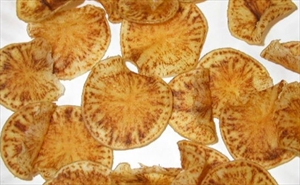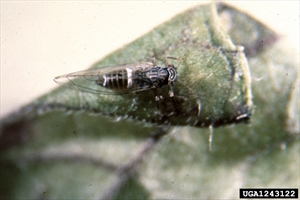Zebra chip disease
Pacific Pests, Pathogens and Weeds - Online edition
Pacific Pests, Pathogens & Weeds
Potato zebra chip (424)
Candidatus Liberibacter solanacearum; there are several strains. This bacterium is closely related to Candidatus Liberibacter asiaticus, and related strains that cause citrus greening (Huanglongbing or greening) disease.
Widespread, mostly in temperate regions. Asia (restricted), Africa (restricted), North and Central America (strains A and B), Europe, Oceania. It was recorded from New Zealand in 2006 (strain A). The tomato-potato psyllid, Bactericera cockerelli, spreads the disease. The psyllid was found in Western Australia in 2017, but without the disease-causing bacterium. The psyllid and the bacterium are present in Norfolk Island an external territory of the Commonwealth of Australia. Carrot strains are reported from Europe and north Africa (strains C,D and E).
Potato, and other members of the Solanaceae, i.e., capsicum (and chillies), eggplants, tamarillo, and tomato. Carrots and celery, and weeds (e.g., nightshade and datura), are also hosts. Cape gooseberry (Physalis peruviana) may be a symptomless host. Note, in Ecuador, purpling and yellowing of this weed has been reported. Carrot, parsley and celery (Apiaceae) are also hosts.
The disease is caused by a bacterium that is spread by a psyllid (Bactericera cockerelli). The bacterium does not survive outside its host.
Plants are stunted, with leaves that show yellowing, purpling, and curling or cupping (Photo 1). Stems have internal browning. They may also develop tubers, and buds on stems develop shoots. Tubers appear healthy, or may show areas of discolouration when cut. When fried, tubers show dark brown streaks - hence the name of the disease (Photo 2). Infected tubers mostly do not sprout, or produce weak plants.
Eggs are yellow-orange laid on stalks on the undersides of leaves or on leaf stalks (Photo 3). The nymphs have a fringe of hairs around the edge of the body (Photo 4). They produce droplets of 'honeydew' on the leaves. Adults about 2-3 mm long, dark green with a white bands across the first and last abdominal segments (Photo 5). They have clear wings, held at an angle of 45 degrees over the body (Photo 6).
Spread of the bacterium occurs with the psyllid (Photos 4-6), and propagating material. Psyllids jump and fly when disturbed, and are likely to move a few kilometres between crops. Longer dispersal is associated with the trade in 'seed' potatoes and seedlings. The bacterium passes to the next generation through the egg. Once a psyllid is infected, it remains infected throughout its life.
Strains that cause leaf curling, yellowing and purpling in carrot are spread by the carrot psyllid, Trioza apicallis.
In New Zealand, crops are rejected for processing or fresh potatoes if the presence of zebra chip symptoms are greater than an average of 1.5-2%. This has meant that crops are not grown for 'seed' potatoes in the north island. Costs of zebra chip to the New Zealand industry are put at between NZ$28 and NZ$62 million a year. Countries free from the disease have imposed bans on imports from those where it exists. The impact of the disease in the US is put at many tens of millions of dollars a year due to loss of production, employment and the cost of insecticides to control the psyllid.
Look for stunted plants with yellowish, purple leaves, similar to a nutrient deficiency. Look for the dark brown lines in fried slices of tubers. Look, too, to find the psyllids in the lower parts of the plant. Look to see the characteristic bands on the back of adults. Sampling is done at the edges of fields. Methods of detection involve PCR and sequencing of the DNA fragment produced.
BIOSECURITY
National biosecurity organisations need to consider imposing quarantines on potatoes and tomatoes (and other hosts) unless originating from countries or areas within countries free from Zebra chip disease and the psyllid that spreads it. Additional, specific testing for the bacterium may be required before consignments are allowed to enter.
NATURAL ENEMIES
A number of predators, including ladybird beetles, brown lacewings, mirids and syrphid larvae are known, and there are parasitoids (Tamarixia and Metaphycus species), but their effects on populations of the psyllid are not well known.
ADVICE TO GROWERS
Check crops regularly. Preferably use yellow sticky cards placed at the edges of crops. If a new disease of potato or tomato is thought present, i.e., plants are showing yellowing, purpling and curling of leaves, and/or insects that look like psyllids, then report the find immediately. Contact an agricultural extension or biosecurity officer.
CULTURAL CONTROL
None recommended.
CHEMICAL CONTROL
The use of insecticides (commonly the neonicotinoid imidacloprid) against the psysllid, Bactericera cockerelli, is the only means of control of the disease.
____________________
When using a pesticide, always wear protective clothing and follow the instructions on the product label, such as dosage, timing of application, and pre-harvest interval. Recommendations will vary with the crop and system of cultivation. Expert advice on the most appropriate pesticide to use should always be sought from local agricultural authorities.
AUTHOR Grahame Jackson
Information from Crosslin JM, et al. (2010) Potato zebra chip disease: A phytopathological tale. Plant Management Network. (https://www.plantmanagementnetwork.org/pub/php/review/2010/zebra/); and Zebra chip. Wikipedia. (https://en.wikipedia.org/wiki/Zebra_chip); and Zebra chip (Candidatus Liberibater solanacearum). Australian Government Department of Agriculture. (http://www.agriculture.gov.au/pests-diseases-weeds/plant/zebra-chip); and from ProMED (2020) Liberibacter solanacearum - south America: First report (Ecuador). (http://www.promedmail.org). Photo 1 Pest and Diseases Image Library, Bugwood.org. Adult psyllid. Photos 3&5 No Liberibacter (zebra chip pathogen) found in potato psyllids in Western Australia. PotatoPRO.com. May 8 2018. (https://www.potatopro.com/news/2018/no-liberibacter-zebra-chip-pathogen-found-potato-psyllids-western-australia). Photos 4&6 Whitney Cranshaw, Colorado State University, Bugwood.org.
Produced with support from the Australian Centre for International Agricultural Research under project HORT/2016/185: Responding to emerging pest and disease threats to horticulture in the Pacific islands, implemented by the University of Queensland and the Secretariat of the Pacific Community.









